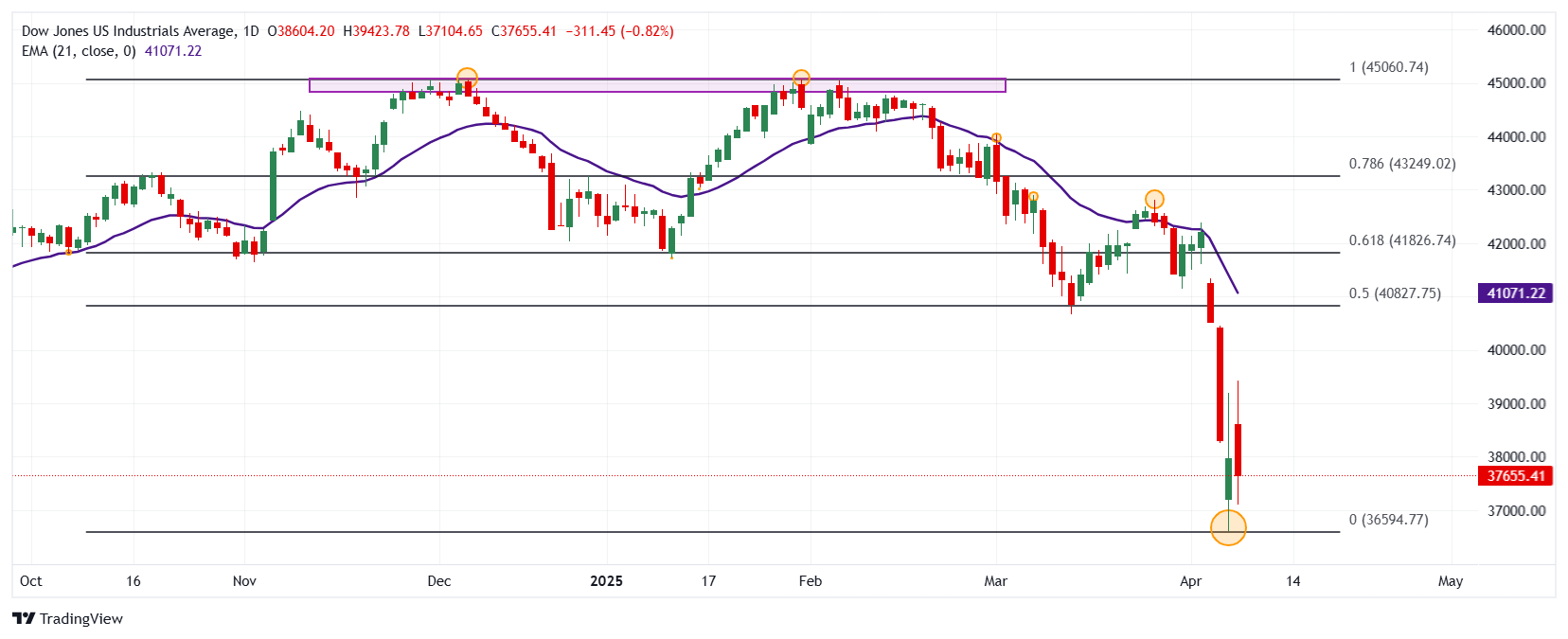- The Dow Jones loses 1.01% today, currently operating at 37,584.
- The Nasdaq 100 goes back 3.05%, consolidating within the operational range of the previous session.
- The S&P 500 falls 1.45% on Tuesday, dragged by Albembarle Corporation (ALB).
- Karoline Leavitt, US press secretary, announced the imposition of total 104% tariffs on China, effective as of April 9.
The Dow Jones marked a maximum of the day in 39,423, attracting aggressive vendors dragged the index to a daily minimum in 37,182.
The Dow Jones industrial average opened at 38,604, while the Nasdaq 100 technological index began operating in 17,536. The S&P 500 began negotiations in 5,112, taking up the bassist perspective after the lack of commercial agreements between the United States and China.
Apple and Nike drag Dow Jones to a negative zone
The Dow Jones index goes back 1.01% daily, losing 375 points, operating at this time over 37.58.
Apple’s titles (AAPL) collapse 4.65% today, taking up the upward perspective, reaching minimums not seen since May 2, 2024 in 172.68 $.
On the other hand, Nike (NKE) shares fall 4.60% on Tuesday, consolidating in minimums not seen in more than seven years over 53.01 $.
In this scenario, Dow Jones reacts downwards from maximum of April 4 in 39,423, reaching a daily minimum in 37,517.
The Nasdaq 100 loses more than 350 points weighed by on semiconductor and microstrategy incorporated
The Nasdaq 100 technological index falls 2.05% in the day, falling 358 points to a minimum daily at 16,861.
The semiconductor (ON) values sink 9.49% daily, reaching minimums not seen since December 29, 2020 in 31.30 $.
In the same tune, Microstrategy Incorporated (MSTR) shares collapse 10.27% today, falling until March 11 at 237.64 $.
The Nasdaq 100 takes up the bearish perspective, in tune with the main share rates, in the middle of an escalation in commercial tensions between the United States and China.
The S&P 500 operates in negative terrain after the tariff escalation on China by Donald Trump
The US Press Secretary Karoline Leavitt announced today the total imposition of 104% tariffs on goods imported from China, effective as of November 9, increasing commercial tensions between the two countries.
After these events, the S&P 500 falls 1.45% today, losing 73 points, operating at the time of writing about 4,970. The actions of Albemarle Corporation (ALB) lead the losses of Tuesday, collapsing 13.05% daily, reaching minimums of more than five years, not seen since March 23, 2020 in 49.43 $.
Technical Analysis of Dow Jones
The Dow Jones reacted down from a short -term resistance given by the maximum of March 26 in 42,820. The next key resistance is observed at 45,068, maximum of January 31. Down, the key support is located at 35,953, a pivot point of December 8, 2023.
Dow Jones daily graphics

Dow Jones Faqs
The Dow Jones Industrial Avenge, one of the oldest stock market indexes in the world, consists of the 30 most negotiated values in the United States. The index is weighted by the price instead of capitalization. It is calculated by adding the prices of the values that compose it and dividing them by a factor, currently 0.152. The index was founded by Charles Dow, also founder of the Wall Street Journal. In recent years it has been criticized for not being sufficiently representative, since it only follows 30 companies, unlike broader rates such as S&P 500.
There are many factors that promote the Dow Jones Industrial Average (DJIA) index. The main one is the added performance of the companies that compose it, revealed in the quarterly reports of business benefits. The American and world macroeconomic data also contribute, since they influence investor confidence. The level of interest rates, set by the Federal Reserve (FED), also influences the DJia, since it affects the cost of credit, on which many companies depend largely. Therefore, inflation can be a determining factor, as well as other parameters that influence the decisions of the Federal Reserve.
Dow’s theory is a method to identify the main trend of the stock market developed by Charles Dow. A key step is to compare the direction of the Dow Jones Industrial Avenge (DJIA) and the Dow Jones Transportation Average (DJTA) and just follow the trends in which both move in the same direction. The volume is a confirmation criterion. The theory uses elements of maximum and minimum analysis. Dow’s theory raises three phases of the trend: accumulation, when intelligent money begins to buy or sell; Public participation, when the general public joins the trend; and distribution, when intelligent money abandons the trend.
There are several ways to operate with the DJ. One of them is to use ETF that allow investors to negotiate the DJ as a single value, instead of having to buy shares of the 30 companies that compose it. An outstanding example is the SPDR Dow Jones Industrial Avenge ETF (day). Future contracts on the DJ allow the specular operators about the future value of the index and the options provide the right, but not the obligation, to buy or sell the index at a predetermined price in the future. Investment funds allow investors to buy a part of a diversified portfolio of DJ values, which provides exposure to global index.
Source: Fx Street
I am Joshua Winder, a senior-level journalist and editor at World Stock Market. I specialize in covering news related to the stock market and economic trends. With more than 8 years of experience in this field, I have become an expert in financial reporting.







